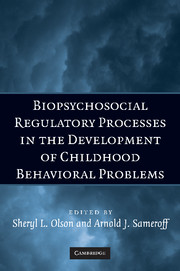Book contents
- Frontmatter
- Contents
- Preface
- Contributors
- 1 Conceptual Issues in Studying the Development of Self-Regulation
- 2 How Gene-Environment Interactions Can Influence the Development of Emotion Regulation in Rhesus Monkeys
- 3 Context Matters: Exploring Definitions of a Poorly Modulated Stress Response
- 4 An Integrative Approach to the Neurophysiology of Emotion Regulation: The Case of Social Withdrawal
- 5 Regulatory Competence and Early Disruptive Behavior Problems: The Role of Physiological Regulation
- 6 Behavior Regulation as a Product of Temperament and Environment
- 7 Self-Regulatory Processes in the Development of Disruptive Behavior Problems: The Preschool-to-School Transition
- 8 Emotional Dysregulation and the Development of Serious Misconduct
- 9 Regulatory Processes in Children's Coping with Exposure to Marital Conflict
- 10 Family Subsystems and Children's Self-Regulation
- 11 Culture and the Development of Regulatory Competence: Chinese–U.S. Comparisons
- 12 Self-Regulation and the Development of Behavioral and Emotional Problems: Toward an Integrative Conceptual and Translational Research Agenda
- Index
- References
10 - Family Subsystems and Children's Self-Regulation
Published online by Cambridge University Press: 02 July 2009
- Frontmatter
- Contents
- Preface
- Contributors
- 1 Conceptual Issues in Studying the Development of Self-Regulation
- 2 How Gene-Environment Interactions Can Influence the Development of Emotion Regulation in Rhesus Monkeys
- 3 Context Matters: Exploring Definitions of a Poorly Modulated Stress Response
- 4 An Integrative Approach to the Neurophysiology of Emotion Regulation: The Case of Social Withdrawal
- 5 Regulatory Competence and Early Disruptive Behavior Problems: The Role of Physiological Regulation
- 6 Behavior Regulation as a Product of Temperament and Environment
- 7 Self-Regulatory Processes in the Development of Disruptive Behavior Problems: The Preschool-to-School Transition
- 8 Emotional Dysregulation and the Development of Serious Misconduct
- 9 Regulatory Processes in Children's Coping with Exposure to Marital Conflict
- 10 Family Subsystems and Children's Self-Regulation
- 11 Culture and the Development of Regulatory Competence: Chinese–U.S. Comparisons
- 12 Self-Regulation and the Development of Behavioral and Emotional Problems: Toward an Integrative Conceptual and Translational Research Agenda
- Index
- References
Summary
The family context plays a critical role in the early development of both normative and psychopathological outcomes (Cummings, Davies, & Campbell, 2000). Parents can be sensitive to their child's needs and express warmth in their interactions, or they can engage in intrusive, rejecting behavior that undermines the child's well-being. Similarly, married couples can communicate effectively, engage in mutual problem solving, and enjoy humorous exchanges, or they can get embroiled in coercive cycles of escalating conflict that can easily end with domestic violence. Fathers may be involved or psychologically unavailable. As these examples attest, the family is composed of a number of family subsystems (e.g., mother-child, marital, father-child, sibling) that can affect the development of children's self-regulation. The interplay among these different subsystems can alter developmental trajectories depending on whether family relationships act as risk or protective factors. For instance, the adverse consequences of marital conflict (a risk) may be buffered or dampened if the child has a close and supportive relationship with one parent in the family (a protective factor). In a two-parent family, the mother-child and father-child relationships can be concordant (both warm and sensitive) or discordant (one warm, one rejecting), and these differences within concordant and discordant families have consequences for the children involved.
The goal of this chapter is to discuss the development of young children's self-regulation in the context of multiple family subsystems.
- Type
- Chapter
- Information
- Biopsychosocial Regulatory Processes in the Development of Childhood Behavioral Problems , pp. 238 - 257Publisher: Cambridge University PressPrint publication year: 2009
References
- 5
- Cited by



